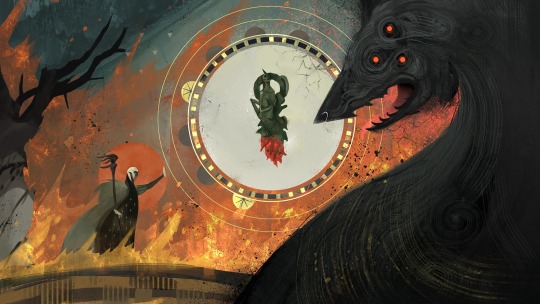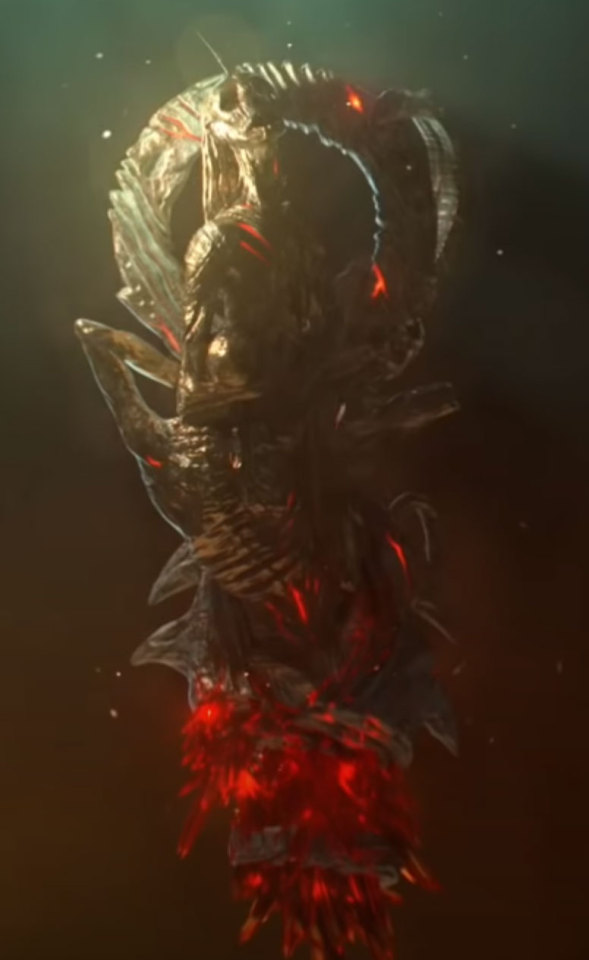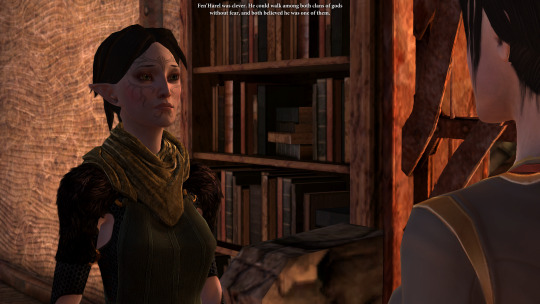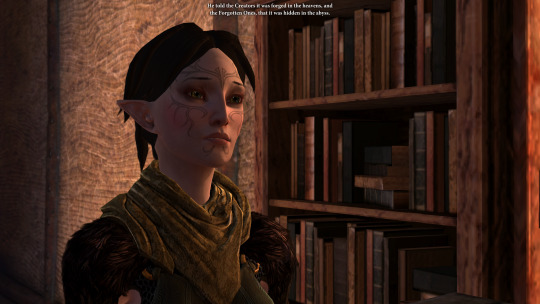#and shows him the murals and tells him all about the dread wolf protecting them. and then she puts him back to bed
Explore tagged Tumblr posts
Text
thought too hard about veilguard era solas and amadea almost playing house 3 dead 9 injured
#they eat meals together and do the dishes afterward and they sleep in the same bed. and fuck but this aint about that#after amadea brings her kids to the lighthouse -- sorin has a nightmare that first night and crawls into bed w them#the way that five year olds do. and amadea holds him for a little bit and then she and solas show him around the lighthouse#no its really just amadea. solas follows but hes awkward around her kids.#and amadea shows sorin how the eluvian is special so theyre protected#and shows him the murals and tells him all about the dread wolf protecting them. and then she puts him back to bed#and casts fake 'protection wards' -- little glowing motes -- around his bed.#solas peering through the fence posts theres the life ive always wanted#sorin finds out very shortly that that nice man mamae hangs around IS the dread wolf#whereupon solas becomes the coolest person in the world to him#carly.txt#carly's ocs#oc: amadea
9 notes
·
View notes
Text
Reading into the red lyrium idol and Solas’ end-game

The lyrium idol seems to be a major plot device in DA4.
The story recounts a group of spies sharing information on Solas and his plans, detailing all the information they know so far with a few lies and/or embellishments interwoven throughout.
There is one thing everyone at the table seems to agree on though and that is: the importance of the red lyrium idol to Solas’ plans.
But is it the same lyrium idol we know of?
In all the spies’ stories, they describe the idol as specifically depicting two figures.
Carta dwarf: ...It’s not much to look at—a couple hugging, too thin to be dwarves—but it’s sitting there, glowing softly like a ruby lit by the grace of the Maker himself. Mortalitasi: When he opened the thick chest marked with the Carta’s protective runes and drew it forth, we saw it clearly—an idol crafted from red lyrium, which seemed to show two lovers, or a god mourning her sacrifice, depending upon how it caught your fancy. Bard (disguised Solas): ...He whispered something as he picked it up, tracing his gloved fingers gently along the crowned figure who comforted the other,
For those of us who have been obsessively squinting at every little detail on the idol from all angles, it’s now quite clear there are in fact three figures on the idol, not two.
The fact that Bioware cleaned up the model from DA2, made the idol the centrepiece of the teaser, and outlined the shape of it in the corresponding mural, indicates that the description of the idol showing two figures in the book is not an accident.

The difficulty in verifying the authenticity of the idol itself is actually one of the biggest questions I have raised since reading the book, and makes me wonder if the lyrium idol in TN is the same as the one Hawke found in DA2.
We already know the Carta assassin was briefed by Varric:
“I’m only here because Viscount Tethras called in a few favors,” he said, smiling broadly, “but I didn’t expect to be the best-informed person in the room. You don’t even know what he wants, and I can tell you that!”
If anyone in Thedas could describe and spot the original idol it would be Varric. He did after all find it with Hawke, and his brother went crazy from it.
How then could his hired spy get the description of the idol wrong, unless he was lying? And even if he was lying, why did the Mortalitasi and Bard (Solas) back him up by also describing the idol as portraying exactly two figures?
They are all spies in the room- they are supposed to pay attention to detail. How could they miss an important detail such as that?
So, after reading this story, I have a lot of questions.
Who is the mysterious third figure in the idol and why did no spy notice it on the idol they described?
Are there multiple idols floating around that we don’t yet know of?
Did Solas plant a decoy, hoping to throw everyone off the real idol? Meaning, is he also still looking for the real idol?
Can he or the idol itself affect how it’s perceived by people in reality?
Did a chunk break off when it was smelted into Meredith’s/Samson’s sword, and is a piece still lying around somewhere in Thedas?
===
The idol’s purpose
It seems that the idol is extremely important to Solas and his plans. He claims it belongs to him, and it is clear he intends to reclaim ownership of it no matter the cost. In fact, he claims to already be in possession of it (though I am doubtful of that).
The Bard (Solas): Slowly, he lifted the red lyrium idol from the pillow where it rested. He whispered something as he picked it up, tracing his gloved fingers gently along the crowned figure who comforted the other, but I could not make out the words, for I fear they were elven... The idol’s journey is now complete, and it has found its master. He will destroy anyone in his way without regret or hesitation, and whatever he intends, I do not believe we can stop it.
According to the Mortalitasi’s story, the idol is in fact a ritual blade:
When our power, plus the power of our arcane possessions, plus the power of his slaves’ lives, had all come to him, the Tevinter mage raised the idol before him, and I saw a spike of lyrium spring from the base of the idol, so that all at once, it was not merely an idol, but a ritual blade. He slashed his own hand, and a wave of power pulsed through the cavern. It was as though we were the blood, and the cavern was the body through which it flowed, and we fell, all of us, to the ground, our minds pulled into the raw chaos of the Fade by the power of his ritual.
It turns out the Mortalitasi actually intended on using the idol as part of a blood magic ritual to bind spirits to their will so they could repel the Antaam invasion.
...every dream, every demon, every half-interested spirit would urge them back to the north, away from humanity. Their resolve would weaken, their invasion would crumble, and all would go back to the way it should be.
Now remember in DA2, Merrill tells us a story of a blade to end the elven civil war when she recounts the story of the Dread Wolf:

“Fen’Harel was clever. He could walk among both clans of gods without fear, and both believed he was one of them.”

“He went to each side, and told them the other had forged a terrible weapon, a blade that would end the war.”

“He told the Creators it was forged in the heavens, and the Forgotten Ones, that it was hidden in the abyss.”
In TN, Solas seems very sentimental towards the idol. This makes me wonder if he made it into a ritual blade, and took the gambit the evanuris would seek it out and unwittingly use their own power to seal themselves away.
It would be so ironic and totally Solas’ MO if that were the case, that the idol which bears Mythal’s resemblance was the key to their own prisons.
===
Why is the idol so important?
We know of the elven upstart. He is a mage named Solas, and his ritual has already started to affect the Fade. We cannot risk him acquiring this idol and finishing what he has begun.

It seems like the idol is at the centre of everything, anchoring the imprisoned evanuris and the Black City in place.
If the Mortalitasi’s blood magic ritual were to succeed, I could imagine mages becoming possessed by a a demon or even one of the evanuris by becoming a willing host. After all, the point of their ritual was to obtain power to defeat their enemies.
In fact, the Mortalitasi’s ritual reminds me a lot of the ritual described in Solas’ secret room in Trespasser which is also reiterated in the Forbidden Oasis. In both instances, a demon is summoned using blood magic to defeat their enemies.
Mythal seemingly used blood magic to win the war against the titans. What if the ritual the Mortalitasi used was in a similar vein?
“YOU MEDDLE PAST YOUR UNDERSTANDING, FOOLISH MORTAL MAGES, AND IN DOING SO, YOU THREATEN ALL CREATION.” “YOU USE MY IDOL CARELESSLY TO VANDALIZE THE SEA OF DREAMS. NOW FEEL THE PAIN OF WHAT YOU HAVE CREATED.”
I am convinced the idol/blade could be used as part of a blood magic ritual to summon a demon, either summoning the evanuris (who I believe are “demons” like Imshael and the like) or a demon from the void.
===
Solas’ end-game
We are led to believe at the end of Trespasser he simply wants to restore the world of his time. Imo that’s only partly true.
I think Solas tearing down the veil is simply the necessary first step for him to destroy the Black City and the false gods for good. This is where I think the idol would come into play.
The veil is also a fabrication created by Solas, and there have been signs throughout the series from DA:O to DA:I that the veil is tearing apart, irreparably.
Demons seize every opportunity, every tear in the Veil, to enter our world. Once the Veil is torn, it is extremely difficult to mend, some say impossible.
What does it mean to pierce the Veil, that which separates our world from the realm of dreams and demons? For the average man and woman, it is a frightening thought to consider just how fragile this separation actually is.
The Veil is not a physical curtain, not a structure limited to a particular place—it is everywhere. It is in their home, in the streets where they walk, in farmers' fields as well as remote mountain vales. At any moment it could be torn to shreds, allowing demons and other horrors to flood into our world like water through a burst dam.
Apart from the Inquisitor, no person in Thedas has successfully been able to seal rifts.
This means over time, with more veil tears and death, the more fragile the veil will be. Eventually, it will break entirely. I think this would be inevitable, whether or not Solas destroys it.
Cole calls the Veil wonderful in Trespasser, because it was created to forbid. And we know the veil forbids all the demons and false gods from entering the physical world. With the idol now floating around in Thedas and with a weakened veil, I think there is a possibility using the idol could summon or release the evanuris from their prisons.
His measurements of the veil and testing of its strength indicates to me he is still trying to see how he can fix the veil or work it into a new plan. With the loss of his orb, the idol may be the last piece of security he has.
This is why I don’t buy the fact that he simply wants to tear down the veil and restore ancient Elvhenan like he wishes he was in the past. There has to be more than that- there is no way he hasn’t accounted for the Redcliffe possibility.
Since Solas is the actual creator of the veil, he alone has a chance at preserving what remains while fixing/amending whatever plans he had for the false gods.
It actually makes a lot of sense that Solas would not want to tell anyone too much about his plans, even the Inquisitor. Not only does he not trust people, I think his actions in TN prove he is worried about the idol falling into the wrong hands and the temptation to use it.
Maybe his actions and letting Charter go free is even an indication that he is manipulating the Inquisition to continue ‘working against him’ when in fact they are a part of his grander plans.
#da4#dragon age#dragon age 4#theory crafting#red lyrium idol#solas#tevinter nights#dai#da theories#drabble#tevinter nights spoilers#the veil
49 notes
·
View notes
Text
The Tree

I thought I’d try and take a stab at or maybe bring up some discussion more about the mural in The Dread Wolf Rises teaser. While the main, central scene of the mural is probably the most riveting and important aspect of the entire piece, another element that seems to have not gotten enough possible theories or its place in the mural is the tree.

A lone, charred tree rises from the fires coming up from the ground.
First off, I’d like to say, yes, it might just be a tree to show the destruction of nature from Solas’ plans and a large, dark counterweight to the looming, black Dread Wolf on the right. However, I’ve thought of some possible things this tree might symbolize and why it’s in the spot it is in.
It’s important to note that none of the other elven frescoes or murals we see have landscapes, they are usually flat ground plains or have simple mountains for depth in the back. Therefore, there is a reason why a tree was placed there in the foreground and not just left empty or delegated to in the background.
First, trees. What do they mean in Thedas--more specifically, for the elves?

At the center of every alienage is the vhenadahl: The Tree of the People. For the city elves, it’s a connection to their heritage and their past while living in a mostly human and discriminatory environment. Thus, the vhenadahl is a symbol of the modern city elves who live in alienages and have mostly assimilated to Thedas’ human culture.
As for the other elves, the Dalish bury their dead beneath great trees as seen in Var Bellanaris in the Exalted Plains.

This tradition carries over to the defenders of the Dales as well during the Exalted March on the Dales, causing the Emerald Graves of the slain elves.
Seeing as Solas wishes to bring back the glory of the ancient elves and by doing so destroy the modern elven culture, it would be fitting that the tree is a symbol of such: the modern elves.
The tree is blackened and charred by the chaos of the scene depicted and stands tall and looming over the elf--Solas (it is probably 99% Solas so that’s what I’m going to refer to the figure as).
A great theory that has been mentioned is what the mural is depicting. More importantly, why is Solas depicted separately from the Dread Wolf? I believe in the idea that it is a represention of Solas’ duality and the pressure of his actions. At the end of Trespasser, it is evident that Solas wishes to be wrong in what he is doing, that there may be some other option than whatever he is planning. Being with the Inquisition, interacting with the people of Thedas, has made him come to doubt his plans, made him realize that the people of Thedas may in fact be people. He is conflicted, and the mural illustrates this conflict by depicting Solas and the Dread Wolf separately.
Solas has his arm raised and a protective barrier surrounding it and his upper body. Rather than leading the Dread Wolf or depicted entirely as it, a great distance separates the two.

This imagery contrasts to what is seen in Solas’ tarot card at the end of Inquisition. Here, he leads the Dread Wolf and the back of his cloak has strings connecting him to it.

Another thing is that they are not shown as being the same person like the mosaics of Fen’Harel in Inquisition and Trespasser:

So, what does the tree have to do with this?
Since there is a high chance that Solas is conflicted with what his plans are and killing millions to right his mistake, the tree and its place in the mural has to be dissected.

Solas has his back to the tree and not at all turned in any manner towards it to acknowledge its existence. I believe that the tree and his relation to it can be interpreted in two ways: a) Solas has turned his back to the modern elves and their destruction through his plan or b) he is protecting what remains of the tree.
For the first point, it’s both represented physically in the mural and mentally for Solas that he does not agree with the modern elves and does not see himself as of the same people as them due to their detachment from the Fade and immortality. Since he cannot connect with them in that way, he would have no real problem if they died in order to bring his people back.
However, Solas has started to doubt his plans. If this extends to if his opinion of the modern elves has changed in some manner by his interactions with them (I would expect that he has been more exposed with the modern elves at this time because of them joining his cause) or a Dalish Inquisitor, it could mean his own opinion on the tree and its meaning to him has changed.
Due to the fact he is telling the Dread Wolf to stay back with his gesture and his position in front of the tree, he may be guarding/protecting what remains of the elven People even if it is twisted and mostly destroyed. Note that the tree does not separate Solas and the Dread Wolf, instead it is delegated to the far left of the composition behind Solas. It is something associated with this side of Solas and not the Dread Wolf and this may be deliberate. It is something his persona/duty does not share and instead the far right is engulfed by the dark void of the wolf’s form entirely.
Another side thing to note: the style of the ground is the same as his romance tarot card.

Here, he reaches to the leaves of a living tree and faces towards it. In the romance, he fools himself to believe that perhaps he can stray from his duty, that he can tell the truth to Lavellan and not live with his guilt and the past that haunts him as Fen’Harel. This may show his growing acceptance to the possibility that the world of modern Thedas may be something to protect and not completely a mistake from his actions, since he decides to admire the life, people, and nature of a Veiled Thedas. However,in the end, he still decides that he cannot forgo his duty and he has to see through fixing his mistakes no matter if he has sentiments for the modern world or not and that he cannot fool himself.
Importantly, the romance card does not change to the tower card after Inquisition and Trespasser, it stays the same. This illustrates that what he has realized and learned by entertaining the thought that the Inquisitor and every one else are people has effected him greatly and especially his outlook.
Whether, in the mural and during the depicted event, he has decided to protect what remains or leave it to its fate is unclear. With so many factors influencing Solas’ decisions, it’s hard to tell how he will combat his doubts coupled with his guilt, pride, and duty.
#this is so long but i need to get it out of my system#this fucking tree has been haunting me#da4#the dread wolf rises#dragon age#dragon age inquisition#bioware#dai#sarah's shenanigans
4 notes
·
View notes